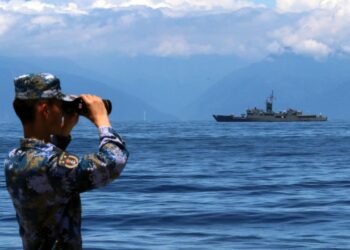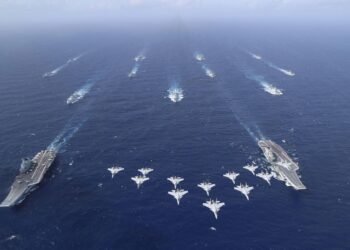It now looks increasingly likely that drones – specifically unmanned surface vehicles (USVs) and unmanned underwater vehicles (UUVs) – will play a growing role in minehunting within a few years. A range of scenarios can be envisaged. The French defence procurement agency (DGA) has asked DCNS and co-contractors Thales Underwater Systems and ECA to help it determine which scenarios are the most promising.
In late 2008, DCNS and co-contractors Thales Underwater Systems and ECA won a DGA contract to determine what assets should replace the French Navy’s fleet of 13 highly effective current-generation minehunters.
Given (a) that these vessels will come up for retirement over the coming decade and (b) their high cost – they are in fact more expensive per tonne than submarines – the question being asked in high places is: What should replace them?
The main options are new-generation minehunters or disruptive-technology solutions based on advanced USVs and UUVs. The Antimidro (or anti-mine drone) technical-and-operational study awarded to prime contractor DCNS will help the DGA and higher authorities to make their choice.
More specifically, this study aims to catalogue advanced solutions, assess their technology readiness level (TRL), then select three on the basis of technological and economic criteria. Work began in March 2009 with each contractor focusing on its own area of excellence: DCNS as systems integrator and naval architect and TUS as mine countermeasures (MCM) systems designer and underwater robotics specialist. The study is scheduled for completion in July 2010.
Innovative technologies
Minehunters are expensive primarily because the limited range of current-generation technologies – specifically the wire-guided remotely-operated vehicles they use to locate and destroy mines – means that they must be designed to work close to danger zones (i.e. suspected mine fields).
To cope with these dangers, minehunters are built from special materials and using special procedures designed to make them undetectable by mines; hence their high cost. On a minehunter, everything made of metal – including canned food – must be stored in such a way as to minimise the boat’s magnetic field.
Emerging trends favour remotely supervised USVs and UUVs enabling host vessels and their crews to remain well clear of suspected mine fields. Future systems using autonomous USVs and UUVs may even be able to operate independently of the host vessel. This last prospect opens up the prospect of minehunters built in much the same way as conventional vessels, hence at significantly lower cost.
A range of scenarios
Next-generation minehunters, USVs, UUVs and the like could work in many different ways. One option would be a minehunter that deploys USVs and/or UUVs directly. Another would be a minehunter that deploys a large, remotely controlled platform-type USV which in turn deploys UUVs. Other options might use unmanned aerial vehicles (UAVs), other offboard systems or combinations thereof.
Expanding knowledge and understanding
The Antimidro study will give the French authorities the information they need to decide how they should invest in this area. The study calls for three sub-studies. The first, entrusted entirely to DCNS, focuses on USV/UUV launch and recovery by surface combatants which involves complex operations calling for disruptive technologies. The second, assigned to TUS, focuses on USV/UUV cooperation as required by certain MCM scenarios. The third, assigned to ECA, focuses on USV/UUV self-protection capabilities including how to avoid obstacles and nets and even data destruction should a drone fall into enemy hands.
Gearing up for tomorrow’s markets
The stakes are high. Mines are cheap, easy to deploy and can cause enormous damage. Since the end of WWII, mines have wrought more damage on naval assets than any other class of weapon. In conflict situations, mines can render straits and choke zones dangerous or impassable for commercial shipping. For countries like Singapore and the Gulf states, among others, for which access to the sea is via a single strait, mines present special challenges.
Given DCNS’s vast experience in complex projects and its international reputation as a leader in minehunter design and construction, the Group is well placed to explore next-generation MCM solutions using USVs and UUVs.
Full speed ahead for Espadon
In June 2009 – and without waiting for the results of the Antimidro study – France launched the Espadon project. Like Antimidro, Espadon was awarded to DCNS in partnership with both TUS and ECA. Whereas Antimidro is a ‘paper study’, Espadon will result in the construction of a large (15-metre-long), remotely controlled platform-type USV deploying UUVs. Espadon system tests are scheduled to take place in 2012.
The French Navy’s current-generation minehunters – wholly designed, developed and built by DCNS – are considered among the world’s best. The Group aims to maintain this international leadership in MCM following the transition from conventional minehunters to next-generation solutions using USVs and UUVs.
The Antimidro study and the Espadon project will put DCNS in a strong position when the new European Defence Agency (EDA) issues calls for tender in this area in a few years’ time.
Mines, in all shapes and sizes
- Bottom mine (aka ground mine): negative buoyancy; remains on seabed; actuated by target’s magnetic field, noise or pressure effects (influence mine); onboard intelligence ranges from ‘dumb’ to ‘smart’.
- Moored mine (aka watching mine): positive buoyancy; moored to float on or below surface; influence-type or triggered by contact.
- Drifting mine: positive or neutral buoyancy; drifts freely; prohibited under Hague Convention, but nevertheless deployed during certain conflicts.
- Moving mine (aka mobile mine): collective term covering mines that can move (e.g. drifting mine) or use powered propulsion; typically feature both long range and a homing system; also typically both sophisticated and expensive.
Note: mine technology is advancing steadily. Some types are increasingly difficult to detect using sonar, hence the term acoustically transparent mine.









